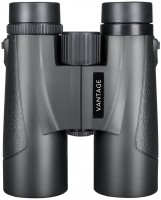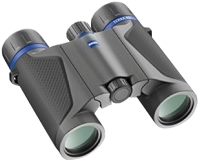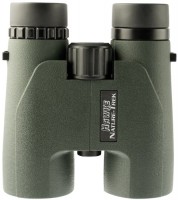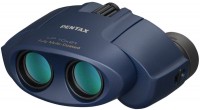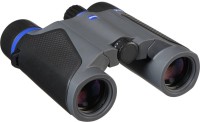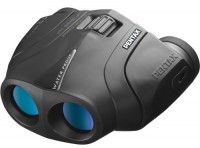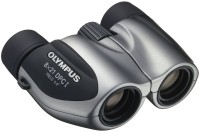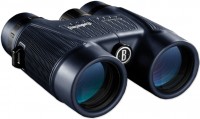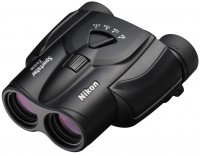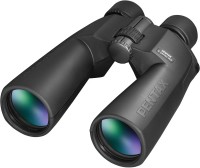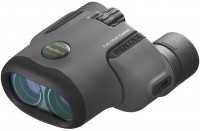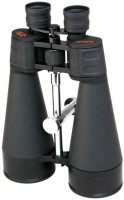Binoculars & Monoculars Levenhuk
All models Advanced filters → |
You might be interested in
Binoculars & Monoculars: specifications, types
Show all
Product type
— Binoculars. Binoculars are portable optical devices designed to observe with two eyes at the same time. They consist of two identical tubes, each of which has a separate optical system. This design provides the effect of a three-dimensional image during observation, moreover, it allows you to observe as naturally as possible without closing one eye. At the same time, binoculars are more expensive, larger and heavier than monoculars with similar optical characteristics; in addition, all their advantages are lost when it is impossible to see normally with both eyes at once — for example, with strabismus or the absence of one eye.
— Monocular. Optical instruments that look like half binoculars or a shortened spyglass; have one eyepiece and are designed for observation with one eye. Such devices do not allow you to get a stereoscopic image, unlike binoculars; on the other hand, they are lighter, more compact and cheaper, besides, they can be used even when it is impossible to see with both eyes at the same time.
Binoculars and monoculars are universal, night, marine, theatrical, astronomical, and for people wearing glasses.
— Monocular. Optical instruments that look like half binoculars or a shortened spyglass; have one eyepiece and are designed for observation with one eye. Such devices do not allow you to get a stereoscopic image, unlike binoculars; on the other hand, they are lighter, more compact and cheaper, besides, they can be used even when it is impossible to see with both eyes at the same time.
Binoculars and monoculars are universal, night, marine, theatrical, astronomical, and for people wearing glasses.
Magnification
The magnification factor indicates how many times the image of any object in the eyepiece will be larger than what is visible to the naked eye. Standard values are 7x, 8x, 10x, 12x, 20x. The higher the magnification, the greater the degree of approximation and the further the distance from which one or another object can be seen through binoculars. On the other hand, increasing the magnification usually means decreasing the angle of view, and it can be very difficult to “catch” an object of interest (especially a moving one) through binoculars. In addition, with the same lens size, a model with a higher magnification will have a smaller exit pupil size and, accordingly, a lower aperture ratio (see below for more details). For models with multiplicity adjustment (see below), this item usually indicates the maximum value of this parameter. The magnification is the first number in traditional markings like 8x40 - this example corresponds to eight-fold optics. If there is a multiplicity adjustment (see below), the markings indicate the entire range - for example, 8-12x40.
Zoom adjustment
The ability to change the magnification of the optics (see above). Models with this function are more versatile than those with a fixed multiplicity. Depending on the situation, they can be used to examine both a large scene (at low magnifications and large viewing angles) and individual small details (vice versa). And if the object is lost from the field of view, you can reduce the magnification and easily find it. On the other hand, the ability to adjust significantly increases the price and reduces the reliability of the entire device.
Optical stabilizer
The presence in the design of the device of an optical image stabilization system — similar to those used in lenses for photographic and video equipment. The effect of such stabilization is based on the use of movable lenses and gyroscopes, which monitor small tremors of the device and make the necessary adjustments to the operation of the optics so that the visible “picture” remains motionless. This function is especially useful at high magnifications, as well as when holding the device in your hands; at the same time, it significantly complicates the design and increases the cost, and also requires a power source (usually in the form of batteries).
Field of view 1 km away
The diameter of the area visible through binoculars / monoculars from a distance of 1 km — in other words, the largest distance between two points at which they can be seen simultaneously from this distance. It is also called "linear field of view". Along with the angular field of view (see below), this parameter characterizes the space covered by the optics; at the same time, it describes the capabilities of a particular model more clearly than data on viewing angles. Models with magnification adjustment (see above) usually indicate the maximum field of view — at the lowest magnification and the widest angle of view. This information is often supplemented by data on the minimum value.
Apparent angular field
The angle of view provided by binoculars/monoculars and available to the eye of the observer. This parameter can be described as the angle between the lines connecting the two extreme points of the image visible in the eyepiece with the eye of the observer; in other words, this is the sector actually observed through binoculars (as opposed to the actual angular field of view described below). The greater the value of this parameter, the greater part of the observed space can be seen without turning the instrument. On the other hand, a wide field of view reduces the magnification factor (see above) — or significantly increases the cost of the device compared to more focused ones.
Real angle of view
The section of the panorama that can be viewed through the eyepieces of binoculars. The higher the actual angular field of view, the wider the visibility of the optics. Note that the angular field of view has an inverse relationship with magnification. That is, the higher the magnification, the narrower the visibility (the smaller the real angular field of view). The actual angular field of view is calculated as follows: you need to divide the angular field of view (in degrees °) by the magnification factor. In comparison, the human eye has an angular field of view of 60 arcseconds (“). In terms of degrees, you get 150 °. Good binoculars provide a real field of view somewhere within 10 arcseconds. But it does not always make sense to chase after large indicators of the real angular field of view. The fact is that when viewing a large section of the panorama, the edges of the image receive noticeable distortion.
Min. focus distance
The smallest distance to the observed object, at which it will be clearly visible through binoculars / monoculars. All such optical instruments were initially created for observing remote objects, therefore, not all of them are able to work at short distances. When choosing a model for this parameter, one should proceed from the expected observation conditions: ideally, the minimum focus distance should not be greater than the smallest possible distance to the observed object.
Twilight factor
A complex indicator that describes the quality of binoculars / monoculars at dusk — when the illumination is weaker than during the day, but not yet as dim as in the deep evening or at night. It is primarily about the ability to see small details through the device. The need to use this parameter is due to the fact that twilight is a special condition. In daylight, the visibility of small details through binoculars is determined primarily by the magnification of the optics, and in night light, by the diameter of the lens (see below); at dusk, both of these indicators affect the quality. This feature takes into account the twilight factor. Its specific value is calculated as the square root of the product of the multiplicity and the diameter of the lens. For example, for 8x40 binoculars, the twilight factor will be the root of 8x40=320, that is, approximately 17.8. In models with power adjustment (see above), the minimum twilight factor is usually indicated at the lowest magnification, but data is often given for the maximum. The lowest value of this parameter for normal visibility at dusk is considered to be 17. At the same time, it is worth noting that the twilight factor does not take into account the actual light transmission of the system — and it strongly depends on the quality of lenses and prisms, the use of antireflection coatings, etc. Therefore, the actual image quality at dusk for two models with the same twilight factor may differ markedly.
Relative brightness
One of the parameters describing the quality of visibility through an optical device in low light conditions. Relative brightness is denoted as the diameter of the exit pupil (see below) squared; the higher this number, the more light the binoculars/monoculars let through. At the same time, this indicator does not take into account the quality of lenses, prisms and coatings used in the design. Therefore, comparing the two models in terms of relative brightness is only possible approximately, since even if the values are equal, the actual image quality may differ markedly.
Phase correction
The presence of a phase correction system in binoculars / monoculars. This feature enhances image quality, such as resolution and colour reproduction, and minimizes colour distortion. The need to use phase correction is due to the fact that the light waves corresponding to different colours differ in length and penetrating power, which is why they also pass through the optical system in different ways. This may cause image quality degradation. To avoid this, special coatings are used in the prisms installed in the device — they retain the original ratio of colour waves and thus provide phase correction.
Diopter adjustment
The presence in binoculars / monoculars of the function of diopter correction. This feature will be very useful if you wear glasses due to nearsightedness or farsightedness. By setting the required number of "plus" or "minus" diopters on the adjustment scale, you can look into the eyepiece with the naked eye and see a clear picture — the optics of the device will provide the necessary correction. It is much more convenient than watching through glasses. However one should not forget that the correction range (see below) is usually small, and in case of serious visual impairments, the capabilities of the binoculars may not be enough; but such situations are still quite rare. In binoculars (see "Type"), this adjustment is usually carried out for each eyepiece separately, because The diopters required for each eye may also be different. Features of the correction control depend on the type of focus (see below). With separate focus, each eyepiece is adjusted with its own regulator, with the central one of the halves (usually the left) is regulated using a common focus handwheel, and the second with a separate knob on the eyepiece (although here there are separate regulators on both eyepieces).
Diopter correction range
The range of values in which diopter adjustment can be made (see above). If you wear glasses with diopters, but plan to look through binoculars / monoculars without them, you should choose a model whose range would correspond to the characteristics of the glasses (or at least be as close as possible to them).
Lens diameter
The lens diameter is the front lens of the binocular/monocular. This parameter is also called "aperture". Designate it in millimetres. Aperture is one of the most important characteristics of an optical device: it describes the amount of light that the device is able to "capture" into the lens, and largely determines the image quality in low light. Therefore, the second number in the traditional marking of binoculars / monoculars is precisely the diameter of the lens — for example, 8x40 mm corresponds to 8x binoculars with an aperture of 40 mm. In addition, with a large lens it is easier to provide a wide field of view without sacrificing magnification. In general, the larger the aperture, the more advanced the optical device is considered. On the other hand, the increase in lenses has a corresponding effect on the weight and dimensions of the entire structure. And you should not forget about the influence of individual components of the system (for example, prisms) on the overall image quality.
Exit pupil diameter
The diameter of the exit pupil created by the optical system of a binocular/monocular. The exit pupil is called the projection of the front lens of the lens, built by the optics in the region of the eyepiece; this image can be observed in the form of a characteristic light circle, if you look into the eyepiece not close, but from a distance of 30 – 40 cm. The diameter of this circle is measured according to a special formula — dividing the diameter of the lens by the multiplicity (see above). For example, an 8x40 model would have a pupil diameter of 40/8=5mm. This indicator determines the overall aperture of the device and, accordingly, the image quality in low light: the larger the pupil diameter, the brighter the “picture” will be (of course, with the same quality of prisms and glasses, because they also affect the brightness). In addition, it is believed that the diameter of the exit pupil should be no less than that of the pupil of the human eye — and the size of the latter can vary. So, in daylight, the pupil in the eye has a size of 2-3 mm, and in the dark — 7-8 mm in adolescents and adults, and about 5 mm in the elderly. This point should be taken into account when choosing a model for specific conditions: after all, fast models are expensive, and it hardly makes sense to overpay for a large pupil if you need binoculars exclusively for daytime use.
Eye relief
The offset is the distance between the eyepiece lens and the exit pupil of an optical instrument (see "Exit Pupil Diameter"). Optimum image quality is achieved when the exit pupil is projected directly into the observer's eye; so from a practical point of view, offset is the distance from the eye to the eyepiece lens that provides the best visibility and does not darken the edges (vignetting). A large offset is especially important if the binoculars / monoculars are planned to be used simultaneously with glasses — because in such cases it is not possible to bring the eyepiece close to the eye.
Focus
The method of aiming the optics of binoculars (see "Type") for sharpness.
— Central. In accordance with the name, focus in this case is carried out using a regulator (usually a rotary handwheel) located in the central part of the binoculars, between the halves. When such a flywheel is turned, both optical systems are adjusted simultaneously — this is convenient, because. allows you to quickly reconfigure the binoculars for different distances. On the other hand, such models are more complex in design than separate ones, have more weight and less reliability.
— Separate. In models with this type of focus, each eyepiece is adjusted separately. This is not as convenient as the central control, but it allows you to reduce the weight, dimensions and price of binoculars, and also facilitates the creation of "protected" devices.
— Automatic. The name in this case is not entirely true: we are not talking about automatic adjustment of optics, but about a fixed focus. Such binoculars do not require focus during use — they allow you to clearly see all objects in the range from the minimum focus distance to infinity, and the observer's eye itself performs the necessary adjustment (similar to what happens when viewing objects at different distances with the naked eye). Models of this type are very convenient for observing on the move, especially when th...e distance to the observed object is constantly changing, as well as in situations where the exact location of the appearance of this object is unknown — they allow you to "target" as quickly as possible and without unnecessary movements. As a result, autofocus is considered optimal for watching sports, wildlife, and the like. The main disadvantage of autofocus can be called the fact that it noticeably tyres the eyes — especially when alternating between the naked eye and the use of binoculars.
— Central. In accordance with the name, focus in this case is carried out using a regulator (usually a rotary handwheel) located in the central part of the binoculars, between the halves. When such a flywheel is turned, both optical systems are adjusted simultaneously — this is convenient, because. allows you to quickly reconfigure the binoculars for different distances. On the other hand, such models are more complex in design than separate ones, have more weight and less reliability.
— Separate. In models with this type of focus, each eyepiece is adjusted separately. This is not as convenient as the central control, but it allows you to reduce the weight, dimensions and price of binoculars, and also facilitates the creation of "protected" devices.
— Automatic. The name in this case is not entirely true: we are not talking about automatic adjustment of optics, but about a fixed focus. Such binoculars do not require focus during use — they allow you to clearly see all objects in the range from the minimum focus distance to infinity, and the observer's eye itself performs the necessary adjustment (similar to what happens when viewing objects at different distances with the naked eye). Models of this type are very convenient for observing on the move, especially when th...e distance to the observed object is constantly changing, as well as in situations where the exact location of the appearance of this object is unknown — they allow you to "target" as quickly as possible and without unnecessary movements. As a result, autofocus is considered optimal for watching sports, wildlife, and the like. The main disadvantage of autofocus can be called the fact that it noticeably tyres the eyes — especially when alternating between the naked eye and the use of binoculars.
Anti reflective coating
Coating is a special coating applied to the surface of the lens. This coating is intended to reduce light loss at the air-glass interface. Such losses inevitably arise due to the reflection of light, and the antireflective coating “turns” the reflected rays back, thus increasing the light transmission of the lens. In addition, this function reduces the amount of glare on objects visible through binoculars/monoculars. There are single-layer, full single-layer, multi-layer, full multi-layer. More details about them:
- Single layer. This marking indicates that one or more lens surfaces (but not all) have a single layer of anti-reflective coating applied to them. This is inexpensive and can be used even in entry-level optical instruments. On the other hand, it filters out a certain spectrum of light, which distorts the color rendition in the visible image - sometimes quite noticeably. In addition, in this case, on some lens surfaces there is no coating at all, which inevitably leads to glare in the field of view. Thus, single-layer coating is the simplest type and is used extremely rarely, mainly in budget models.
- Full single layer. A variation of the single-layer coating described above, in which an anti-reflective coating is present on all surfaces of the lenses (at each air-glass interface). Although this option is al...so characterized by color distortion, it is devoid of another, the most key drawback of “incomplete” enlightenment - glare in the field of view. And the mentioned color distortion is most often not critical. With all this, full single-layer coating is relatively inexpensive, which is why it is very popular in entry-level and entry-mid-level models.
- Multi-layered. A type of coating in which multiple layers of reflective coating are applied to one or more lens surfaces (but not all). The advantage of such a coating over a single-layer coating is that it uniformly transmits almost the entire visible spectrum and does not create noticeable color distortions. The absence of a coating on individual surfaces reduces the cost of the device (compared to full multi-layer coating), but it is impossible to completely get rid of glare in such a system.
- Fully multi-layered. The most advanced and effective of modern types of coating: a multilayer coating is applied to all surfaces of the lenses. This way, high brightness and clarity of the “picture” is achieved, with natural color rendition and no glare. The classic disadvantage of this option is its high cost; Accordingly, full multi-layer coating is typical mainly for high-end models.
- Single layer. This marking indicates that one or more lens surfaces (but not all) have a single layer of anti-reflective coating applied to them. This is inexpensive and can be used even in entry-level optical instruments. On the other hand, it filters out a certain spectrum of light, which distorts the color rendition in the visible image - sometimes quite noticeably. In addition, in this case, on some lens surfaces there is no coating at all, which inevitably leads to glare in the field of view. Thus, single-layer coating is the simplest type and is used extremely rarely, mainly in budget models.
- Full single layer. A variation of the single-layer coating described above, in which an anti-reflective coating is present on all surfaces of the lenses (at each air-glass interface). Although this option is al...so characterized by color distortion, it is devoid of another, the most key drawback of “incomplete” enlightenment - glare in the field of view. And the mentioned color distortion is most often not critical. With all this, full single-layer coating is relatively inexpensive, which is why it is very popular in entry-level and entry-mid-level models.
- Multi-layered. A type of coating in which multiple layers of reflective coating are applied to one or more lens surfaces (but not all). The advantage of such a coating over a single-layer coating is that it uniformly transmits almost the entire visible spectrum and does not create noticeable color distortions. The absence of a coating on individual surfaces reduces the cost of the device (compared to full multi-layer coating), but it is impossible to completely get rid of glare in such a system.
- Fully multi-layered. The most advanced and effective of modern types of coating: a multilayer coating is applied to all surfaces of the lenses. This way, high brightness and clarity of the “picture” is achieved, with natural color rendition and no glare. The classic disadvantage of this option is its high cost; Accordingly, full multi-layer coating is typical mainly for high-end models.
Prism
A type of prism used in binocular/monocular construction. A prism is one of the key elements of an optical system: it is a glass polyhedron through which light passes on its way from the lens to the eyepiece. The need to use such polyhedra is associated with the peculiarities of the creation of optical devices of high multiplicity. In other models, there are two main options:
— Porro. A distinctive feature of binoculars with such prisms is that the optical axes of the eyepieces are offset relative to the lenses — in other words, the distance between the eyepieces differs from the distance between the output lenses. This makes the design somewhat more cumbersome than with Roof prisms; on the other hand, the lenses can be spread over a long distance, which provides a better sense of the volume of the observed picture — especially at long distances. In addition, binoculars with Porro prisms are easier to equip with interpupillary distance adjustment (see below).
— Roof. In models with prisms of this type, the eyepiece and the objective are on the same optical axis — the binoculars look as if the light in it goes from "input" to "exit" directly, without any prism at all (although in reality this, of course, is not So). Such devices are smaller and lighter than Porro systems, but more complex and more expensive.
— Porro. A distinctive feature of binoculars with such prisms is that the optical axes of the eyepieces are offset relative to the lenses — in other words, the distance between the eyepieces differs from the distance between the output lenses. This makes the design somewhat more cumbersome than with Roof prisms; on the other hand, the lenses can be spread over a long distance, which provides a better sense of the volume of the observed picture — especially at long distances. In addition, binoculars with Porro prisms are easier to equip with interpupillary distance adjustment (see below).
— Roof. In models with prisms of this type, the eyepiece and the objective are on the same optical axis — the binoculars look as if the light in it goes from "input" to "exit" directly, without any prism at all (although in reality this, of course, is not So). Such devices are smaller and lighter than Porro systems, but more complex and more expensive.
Prism material
Material used for prisms found in binoculars and monoculars.
- BK-7. A type of borosilicate optical glass (6LR61), a relatively inexpensive and at the same time quite functional material that provides, although not outstanding, quite acceptable image quality. Used in entry-level and mid-level models.
—BaK-4. Barium optical glass, noticeably superior to BK7 in brightness and image clarity, is however also more expensive. Accordingly, it is found mainly in the premium segment.
- BK-7. A type of borosilicate optical glass (6LR61), a relatively inexpensive and at the same time quite functional material that provides, although not outstanding, quite acceptable image quality. Used in entry-level and mid-level models.
—BaK-4. Barium optical glass, noticeably superior to BK7 in brightness and image clarity, is however also more expensive. Accordingly, it is found mainly in the premium segment.
Low dispersion glass
The presence in the design of the optical device of lenses made of low-dispersion glass: ED (Extra-low Dispersion), LD (Low Dispersion), SLD (Special-low Dispersion), ELD (Extraordinary-low Dispersion), UL (Ultra-low Dispersion), etc. P.
Such elements in the optical design are responsible for minimizing the level of dispersion - this phenomenon is characterized by the “stratification” of the light stream after refraction, since different parts of the spectrum are refracted at different angles. Delamination entails a loss of image clarity and provokes the appearance of chromatic aberrations - colored borders at the boundaries of high-contrast transitions along the edges of individual objects. Low dispersion glass ensures the refraction of all light waves at the same angle, thereby minimizing chromatic distortion and improving color rendering and resolution parameters. At the same time, the use of such glass significantly affects the cost of the optical device, so low-dispersion glass often remains the prerogative of high-end models.
Such elements in the optical design are responsible for minimizing the level of dispersion - this phenomenon is characterized by the “stratification” of the light stream after refraction, since different parts of the spectrum are refracted at different angles. Delamination entails a loss of image clarity and provokes the appearance of chromatic aberrations - colored borders at the boundaries of high-contrast transitions along the edges of individual objects. Low dispersion glass ensures the refraction of all light waves at the same angle, thereby minimizing chromatic distortion and improving color rendering and resolution parameters. At the same time, the use of such glass significantly affects the cost of the optical device, so low-dispersion glass often remains the prerogative of high-end models.
Interpupillary adjustment
The ability to change the distance between the eyepieces of the binoculars. This allows you to optimally adjust the device to the distance between the pupils of the user's eyes — and after all, this distance may differ for different people, and mismatch in size can cause inconvenience. This function will be especially useful if a child will use the device — without adjustment, he will not be able to look into both eyepieces of full-size binoculars (whereas an adult can use a model that is not quite suitable for eyepiece spacing, although without much comfort).
Interpupillary distance
Interpupillary distance adjustment range provided in binoculars with the corresponding function.
Recall that, ideally, the interpupillary distance of the device should correspond to the distance between the centers of the pupils of the user himself. With this calculation, it is worth choosing binoculars according to this parameter; and if the device will be used by several people, it is worth making sure that they all “fit” into the adjustment range of the selected model. However, not every person knows exactly their interpupillary distance, especially since it changes with age; and the circle of users can be indefinite — for example, if we are talking about "rolling" binoculars in the hunting industry. In such cases, it is worth proceeding from the following.
In adults of more or less standard physique, the interpupillary distance is in the range from 60 to 66 mm. Modern binoculars cover this range with a margin — even the most modest models support values from 60 to 70 mm, and in most cases the lower limit of the range lies in the region of 54 – 57 mm, and the upper one — 72 – 75 mm. This is quite enough for most adults, including those with a non-standard physique — miniature, or vice versa, large. So a wider range may come in handy only in special cases. For example, if a child will use binoculars, it is desirable that the lower adjustment limit be lower than the standard 50 – 55 mm (in some models, this limit is at the level of 38 mm, or even 34 mm).
Recall that, ideally, the interpupillary distance of the device should correspond to the distance between the centers of the pupils of the user himself. With this calculation, it is worth choosing binoculars according to this parameter; and if the device will be used by several people, it is worth making sure that they all “fit” into the adjustment range of the selected model. However, not every person knows exactly their interpupillary distance, especially since it changes with age; and the circle of users can be indefinite — for example, if we are talking about "rolling" binoculars in the hunting industry. In such cases, it is worth proceeding from the following.
In adults of more or less standard physique, the interpupillary distance is in the range from 60 to 66 mm. Modern binoculars cover this range with a margin — even the most modest models support values from 60 to 70 mm, and in most cases the lower limit of the range lies in the region of 54 – 57 mm, and the upper one — 72 – 75 mm. This is quite enough for most adults, including those with a non-standard physique — miniature, or vice versa, large. So a wider range may come in handy only in special cases. For example, if a child will use binoculars, it is desirable that the lower adjustment limit be lower than the standard 50 – 55 mm (in some models, this limit is at the level of 38 mm, or even 34 mm).
Ergonomic eyecups
The presence of beveled eyecups(or one eyecup, in the case of monoculars — see "Type") in the design of the device. The elongated part of the eyecup during operation is located on the outside of the eye, almost on the temple; due to this, it provides additional protection for the eye — primarily from extraneous "flare" that interferes with normal viewing of the image in the eyepiece. At the same time, such models do not go well with glasses: at best, the eyecup will have to be turned up, negating all its advantages, and in some devices this is not even possible.
Nitrogen filled
The presence of a special gas in the body of binoculars / monoculars — usually nitrogen or argon. Due to its chemical inertness, such a gas does not oxidize internal parts (unlike the oxygen contained in the air). In addition, this function assumes the tightness of the case, which allows most of these binoculars to endure even diving under water (for more details, see "Dust and water protection"), and also protects the optics from the harmful effects of fog. All this has a positive effect on the reliability and service life of the device. In turn, the gas filler itself contains practically no water vapor — thanks to this, the lenses do not fog up from the inside, as happens with conventional models during temperature changes.
Range finder
The presence of a rangefinder in the design of binoculars / monoculars. Rangefinder, as the name implies, allows you to measure the distance to a specific object; but the specific methods of such measurement may vary. The simplest and most common variant is the reticle visible in the eyepieces; such rangefinders are inexpensive and work without batteries. On the other hand, the very procedure for using them is not very convenient, because requires knowledge of the dimensions of the object being used for measurement, as well as the ability to apply certain formulas. Active laser rangefinders are more convenient: with such a device, it is enough to point the binoculars mark at the target and press the button — the automation will do the rest. Their main disadvantage is the high price; in addition, the laser requires a power source to operate.
Compass
The presence of a compass in the design of binoculars (see "Type"; in monoculars, this function is practically not found for a number of technical reasons). A compass can be useful for navigating the terrain, especially when you are away from civilization — for example, during a hiking or hunting trip. In most cases, it is made in the form of a separate scale with an arrow installed in the upper part of the case; usually such models are professional, and the built-in compasses are not inferior in accuracy to ordinary tourist ones. And in the most advanced devices, the compass scale is superimposed directly on the image visible in the eyepieces — this is very convenient when determining azimuths for individual objects.
Design (elements/groups)
The number of elements that make up the optical system of the binoculars / monocular, as well as the groups in which these elements are combined. Individual lenses are called elements. The more of them are used in the design — the more advanced it is considered, the more various tricks the designers used to build a high-quality image with a minimum of distortion. The same can be said about the number of groups (a group can be called several bonded lenses, or a separately located single lens). On the other hand, the abundance of details complicates the design and makes it more expensive; in addition, image quality depends not only on the quantity, but also on the characteristics of the system components. Therefore, in itself, numerous elements/groups is not an indicator of the high quality of the binoculars/monoculars.
Shockproof
The presence in the design of binoculars/monoculars of a reinforced body that protects sensitive optics from bumps and falls. The degree of such protection may vary between models, but even the simplest of them can usually withstand an accidental fall from your hands onto a hard surface without stones or other dangerous objects.
Dustproof, water resistant
The body of the binocular / monocular is protected from dust and moisture. You should pay attention to such models if you plan to use the device in nature — while hiking, hunting, fishing, etc. The degree of such protection can vary, from splash resistance to water immersion; this point should be clarified according to the official characteristics. Also note here that most of the "waterfowl" models usually have gas filling (see above), and the absence of such filling, usually, indicates low moisture resistance.
UV protection
The presence of protection in binoculars / monoculars that prevents ultraviolet radiation from entering the eye of the observer and the unpleasant consequences of this. The role of such protection is usually played by a special lens coating; its presence is highly recommended if you plan to use the device in bright daylight.
Case
The presence of a cover in the scope of supply of binoculars / monoculars. The case is useful for transporting the device — it protects it from shock and dirt, to which complex optics are very sensitive.
Tripod adapter
The presence in the design of the binoculars / monocular socket for attaching an adapter for a tripod(the adapter itself is not included in the kit, unless otherwise indicated). This feature is especially important for high magnification models (see above): they are usually heavy, making it difficult to hold stable in your hands, and at high magnification, even slight shaking can make observation impossible. In addition, mounting on a tripod is convenient for constant observation of a certain place, and such observation does not always require high magnification. Therefore, even fairly small devices can have the possibility of attaching an adapter. The adapters themselves can be designed for different sizes of tripod mounts — this must be taken into account when choosing such a model.

